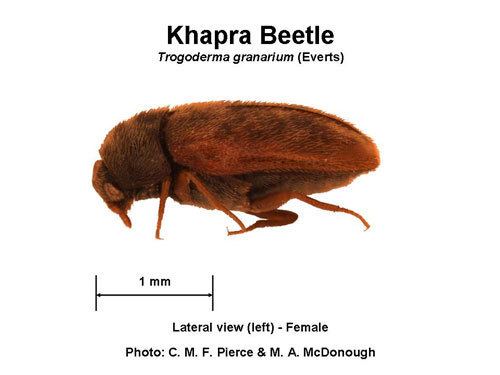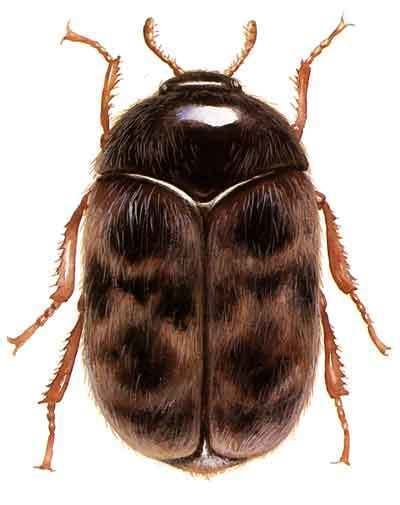Order Coleoptera Higher classification Trogoderma | Scientific name Trogoderma granarium Rank Species | |
 | ||
Similar Trogoderma, Beetle, Insect, Dermestidae, Rhyzopertha dominica | ||
Dissection of khapra beetle larvae
The Khapra beetle (Trogoderma granarium), also called cabinet beetle, which originated in South Asia, is one of the world’s most destructive pests of grain products and seeds. It is considered one of the 100 worst invasive species in the world. Infestations are difficult to control because of the insect's ability to survive without food for long periods, its preference for dry conditions and low-moisture food, and its resistance to many insecticides. There is a federal quarantine restricting the importation of rice into the U.S,. from countries with known infestations of the beetle.
Contents
- Dissection of khapra beetle larvae
- Khapra beetle nearly escapes inspectors
- Description of the insect
- Extent of global spread
- Chemical control
- References

Khapra beetle nearly escapes inspectors
Description of the insect

Adult beetles are brownish and 1.6–3 mm long. Immature larvae are up to 5 millimeters long and are covered in dense, reddish-brown hair. The eggs of the khapra beetle are cylindrical with one end more rounded and the other more pointed, about 0.7 mm long and 0.25 mm broad, weighing about 0.02 mg. The pointy end has a number of spine-like projections. The eggs are initially a milky white but over several hours turn a pale yellowish color.
Extent of global spread
The khapra beetle is native to India and has become established in a number of Mediterranean, Middle Eastern, Asian and African countries. It has also been discovered in North America. Scientists have discovered it in Chicago. Customs specialists have intercepted the beetle 100 times in 2011, "compared to three to six per year in 2005 and 2006, and averaging about 15 per year from 2007 to 2009." The beetle prefers hot, dry conditions and can be found in areas where grain and other potential food is stored, such as pantries, malthouses, grain and fodder processing plants, and stores of used grain sacks or crates.
Chemical control
Fumigation with methyl bromide is the most effective treatment. Powdered neem has been used to control the beetle in wheat stores in India. Neem powder repels many insects due to its strong odor, but generally does not kill insects. However, it is still useful in protecting crops from infestations.
